2023
Skip to Roman Republican, Imperial and provincial, Byzantine, Turkoman, Crusader
Greek:
 Alexander the Great
Alexander the Great
early posthumous
25 mm. 17.15 grams.
Price 255
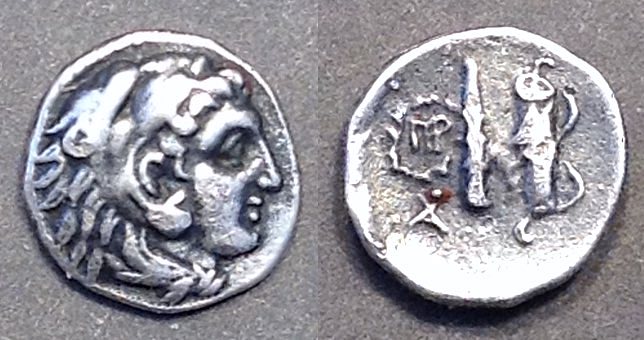 Alexander the Great, hemiobol(?) [possibly a light obol]
Alexander the Great, hemiobol(?) [possibly a light obol]
8 mm. 0.48 grams
Price 3729 "316-311 BC"
Roman, imperial and provincial:
 Roman Republican
Roman Republican
Hybrid. 17.5 mm. 3.21 grams.
56 BC
C. Memmi C. F.
Obverse of Cr. 430 and reverse of Cr 427/1
A contemporary counterfeit made with transfer dies according to Andrew McCabe.
 Vespasian and Titus
Vespasian and Titus
24-23 mm. 14.67 grams.
It has heads of both Vespasian and Titus.
It is a large Syrian tetradrachm, 24-23 mm and 14.67 grams.
AYTOKRAT KAIΣA OVEΣΠAΣIANOV
(Of Autokrater [imperator] Caesar Vespasian)
Bust of Vespasian left over eagle with wings spread
T ΦΛAVI OVEΣΠ KAIΣ ETOVΣ NEOY IEPOY
(Titus Flavius Vespasian Caesar Year New Holy [2])
Head of Titus right, lituus behind
It is from year 2 of Vespasian, 69/70 AD as indicated by the B with a bar above it in front of the neck of Titus.
McAlee 331. Prier 109. RPC II 1944.
 Anonymous quadrans
Anonymous quadrans
15.5 mm. 2.41 grams.
early 2nd C?
Griffin right with paw on wheel
Tripod with globe on it.
Old RIC II p. 218, 27
Sear I 2926
 Hadrian, 117-138
Hadrian, 117-138
33 mm. 21.12 grams
Alexandria, Egypt
Isis Pharia advancieng right, holding sail and sistrum, the Pharos lighthouse before her.
LIZ for year 17 = 132/3
Sear Roman II 3775 (date variety LIH)
RPC III 5838
 Septimus Severus
Septimus Severus
Abgar VIII, 179-214.
24 mm. 6.9 grams.
Mint of Edessa.
Bust of Septimius Severus right
CEOVHPO ATOVAP(?)
Severus Autokrater?
Bust of Abgar VIII right in cap
BACIΛЄΩC ABΓAΡOC ["Abgar" begins at 1:00]
BMC Mesopotamia, Edessa 14.
 Caracalla
Caracalla
19.6 mm. 3.65 grams.
Caracalla bust right, laureate
Turreted Tyche of the city right.
There are many minor legend variants. This one seems to be (From 1:00) approximately
M AVR ANTONINIANA AVC AV
and (from 12:00)
COL MET ANTONINIANA AV
Edessa was a colony (COL) and Metropolis (MET) and took the name of Caracalla (ANTONIN...) . In the 2016 Numismatic Chronicle Dandrow proves it it really of Edessa and not Carrhae as previously repeated uncritically since the type was originally (mis)identified in 1828.
This example is unusually nice for the type.
 Maximinus Thrax, 235-238
Maximinus Thrax, 235-238
36.8 - 35.7 mm.
Very large provincial from Tarsos, Cilicia
SNG Levante 1100
RPC on line 7105 (temporary)
 Otacilia Severa, wife of Philip I (244-249)
Otacilia Severa, wife of Philip I (244-249)
24.5 mm. 11.18 grams.
Nisibis in Mesopotamia
 Claudius II, 268-270
Claudius II, 268-270
21-19 mm. 3.20 grams.
VICTORIA GOTHIC
SPQR mint, said to be Cyzicus
RIC V.I. 252
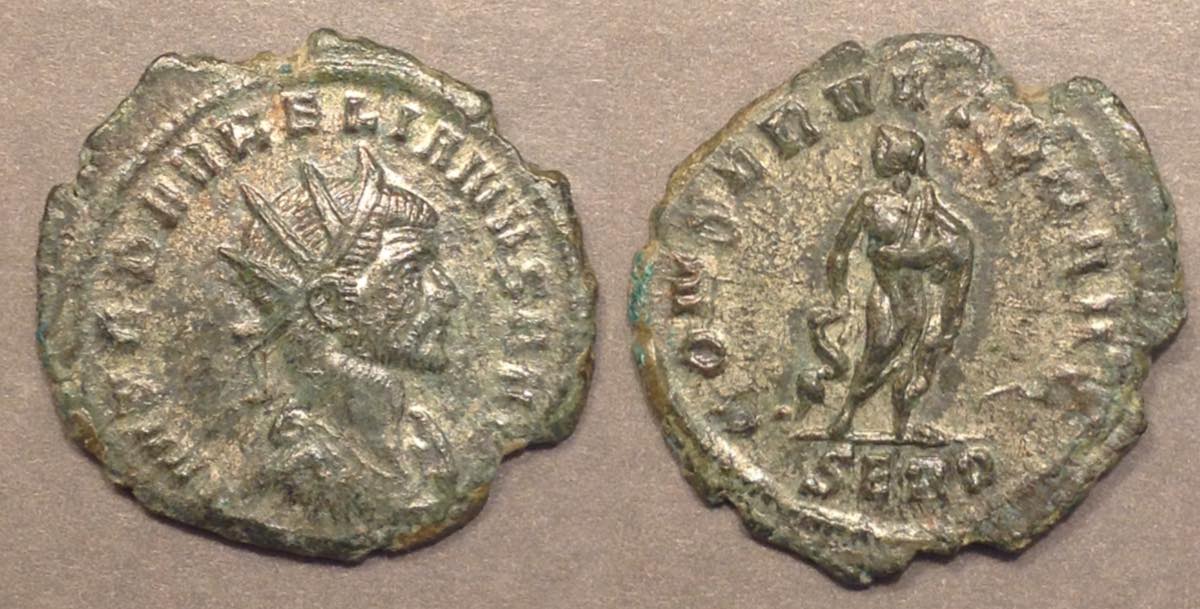 Aurelian, 270-275
Aurelian, 270-275
CONSERVATOR AVG
SERD
RIC V.I Aurelian 258. Serdica mint
This is the first imperial issue with a mintmark which identifies a city clearly.
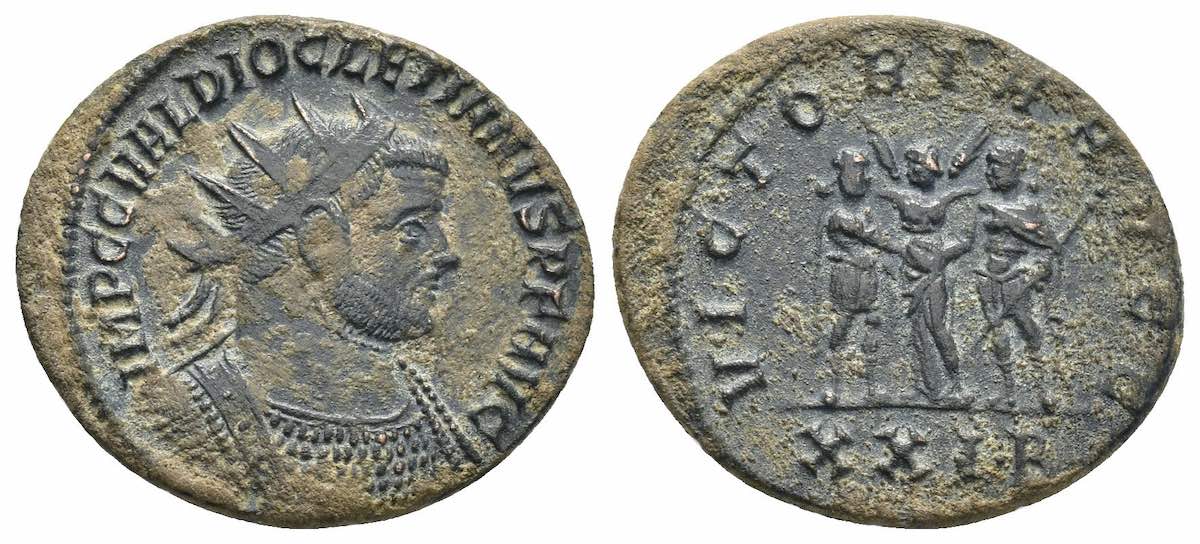 Diocletian, 284-305
Diocletian, 284-305
23.5-20.4 mm. 4.07grams.
Radiate
VICTORIA AVGG
XXI B
Victory between Diocletian and Maximian, all standing
Types with three full-size figures are rare.
RIC V.II 280v (has B, not F)
 Diocletian, 284-305
Diocletian, 284-305
26-24.3 mm. 8.21 grams.
RIC VI Antioch 52a "c. 299-300"
Wonderful orange cover over black patina
 Galerius, as Augustus
Galerius, as Augustus
at Heraclea Thracia
30-27 mm. 9.42 grams.
RIC VI Heraclea 24a
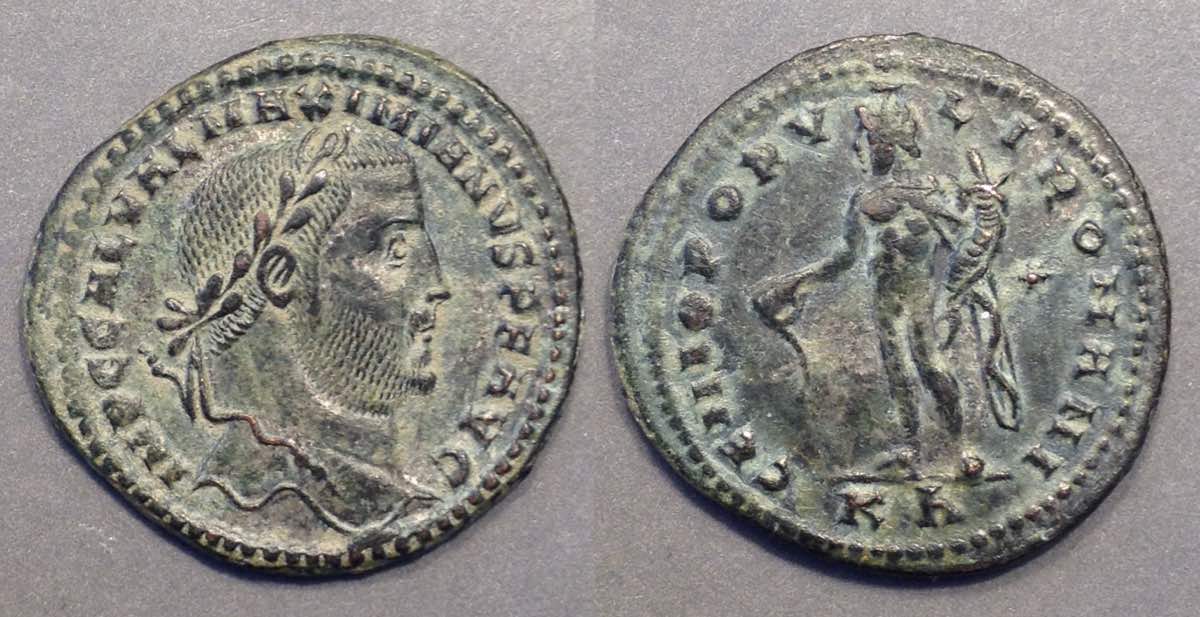 Galerius, as Augusus
Galerius, as Augusus
at Cyzicus
27 mm. 8.49 grams.
Cyzicus, unlike the other mints, used the legend
GENIO AVGG ET CAESS NN
for Caesars, so get
GENIO POPVLI ROMANI for Galerius at Cyzicus it has to be a Second Tetrarchy piece when Galerius was Augustus.
RIC VI Cyzicus 27b
 Constantine as Caesar, 306-307
Constantine as Caesar, 306-307
26.5-25.4 mm. 8.08 grams.
Struck at Lugdunum
RIC VI Lyons 214b
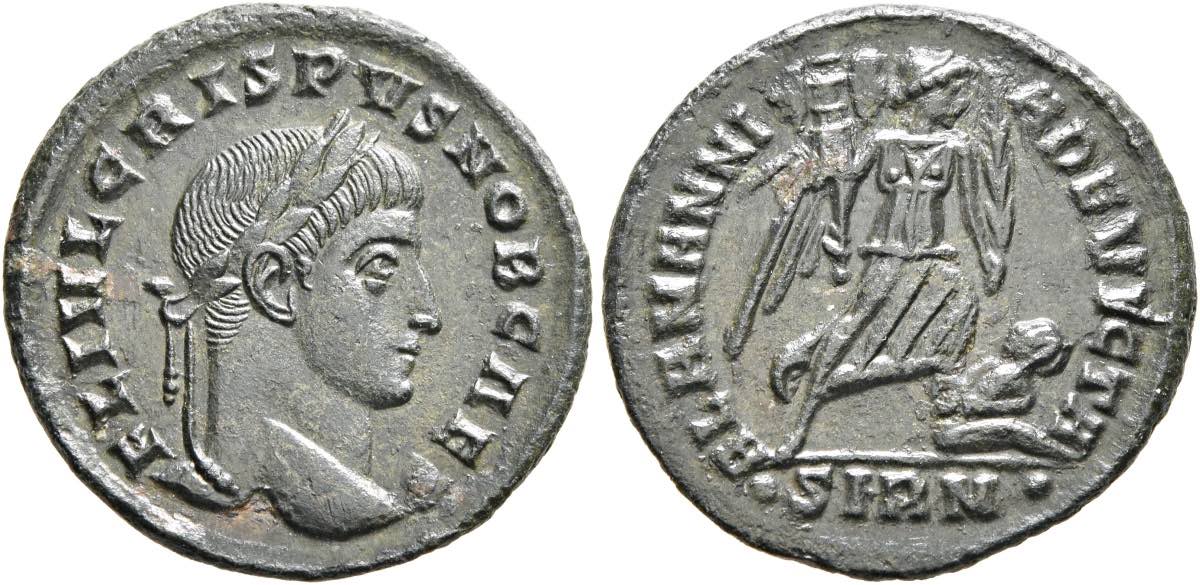 Crispus, 317-326
Crispus, 317-326
18.7 mm. 2.77 grams.
ALAMANNI-A DEVICTA
SIRM
RIC VII Sirmium 49 "324-5"

Fausta, wife of Constantine. d. 326
19.4-18.1 mm. 2.90 grams.
SALVS REIPVBLICAE
A
CONS
RIC VII Constantinople 12 "r3"
Sear III 16551
 Delmatius, 335-337
Delmatius, 335-337
19 mm. (Large for the type) 2.40 grams.
Two standards
RIC VII Siscia 239
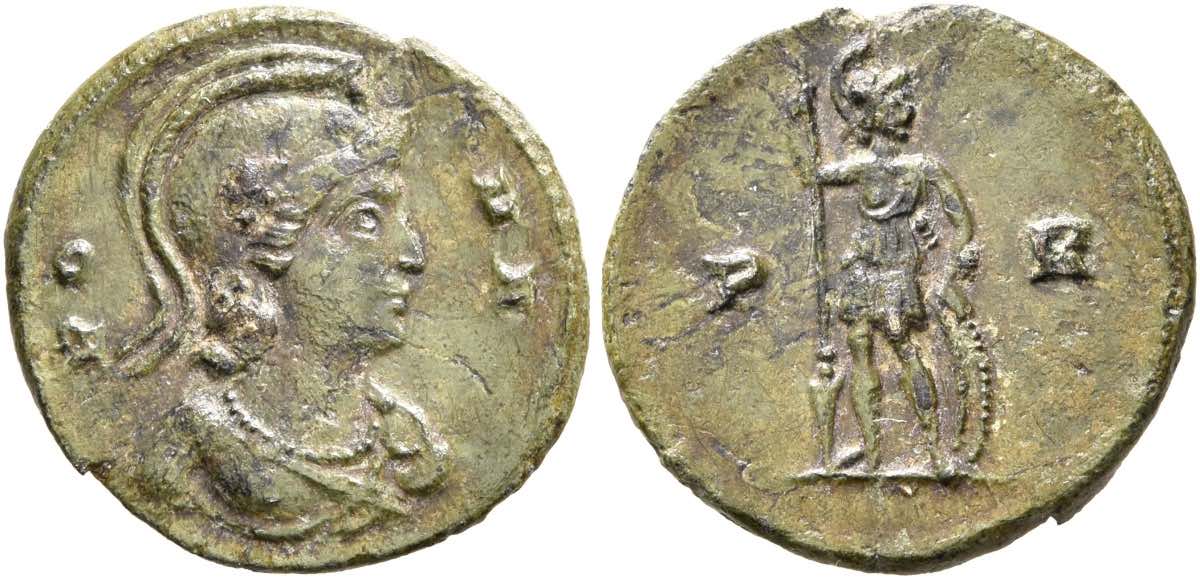
ROMA
P R
15.4 mm. 1.40 grams.
RIC VIII Rome 104 "R4" c. 348 (However, it is much more common than R4 was when RIC VIII was written.
Sear V 17544
Byzantine:
 Justin, 518-527
Justin, 518-527
32-31 mm. 16.10 grams.
* *
K M Y
INSЄ
Dated by indiction number!
Struck 526/7 during indiction 5 at Cyzicus.
I saw one of these in a collection at a monestary in Oregon that I visited in 1984. I have coveted the type ever since. Finally I found one I could afford. I have not seen any that are much better.
Sear 96.
Rare!
 Justinian, 527-565
Justinian, 527-565
34-32 mm. 17.63 grams.
Struck 531-537
Antioch
Sear 214

Justinian, 527-565
34 mm. 18.08 grams.
Antioch
Rare for having stars either side of the M, unlike the star and cresent of the previous coin.
Sear 215A
 Justinian, 527-565
Justinian, 527-565
42.5 mm. 21.98 grams.
Nicomedia
Year 13
Sear 201
Huge flan!
 Justinian, 527-565
Justinian, 527-565
27.6 mm. 9.10 grams.
Struck 537 at Rome immediately after its reconquest--earliest style
ROMA
Sear 292
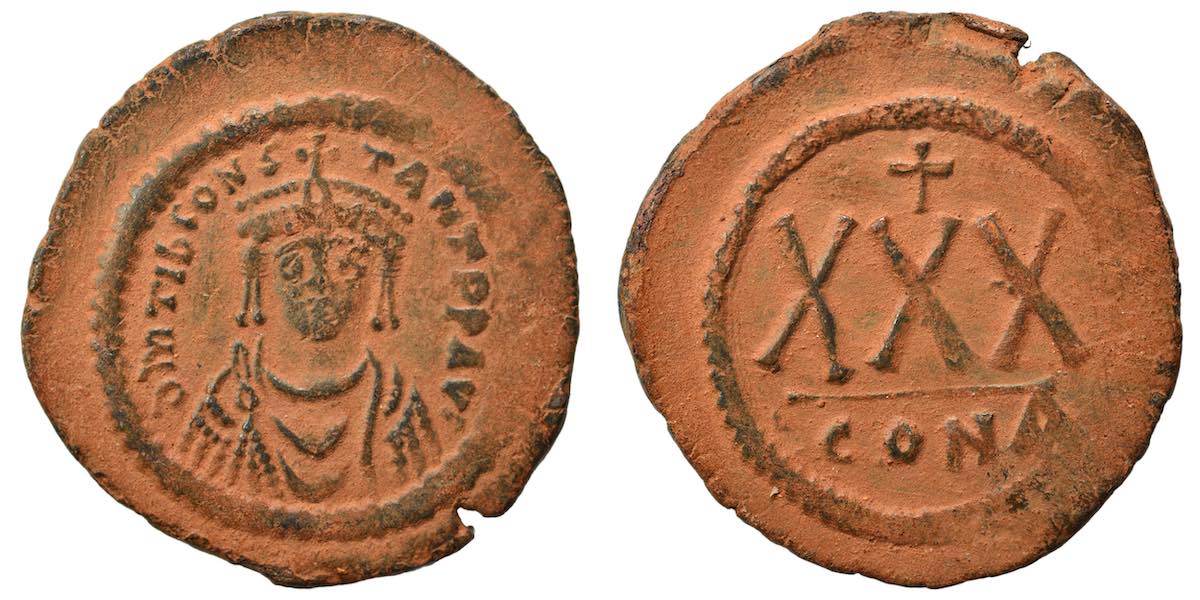 Tiberius II, 578-582
Tiberius II, 578-582
34 mm. 12.76 grams
XXX
CONA
Sear 432
Wonderful color.
 Maurice, 582-602
Maurice, 582-602
20 mm. 4.94 grams.
Thessalonica
Sear 509
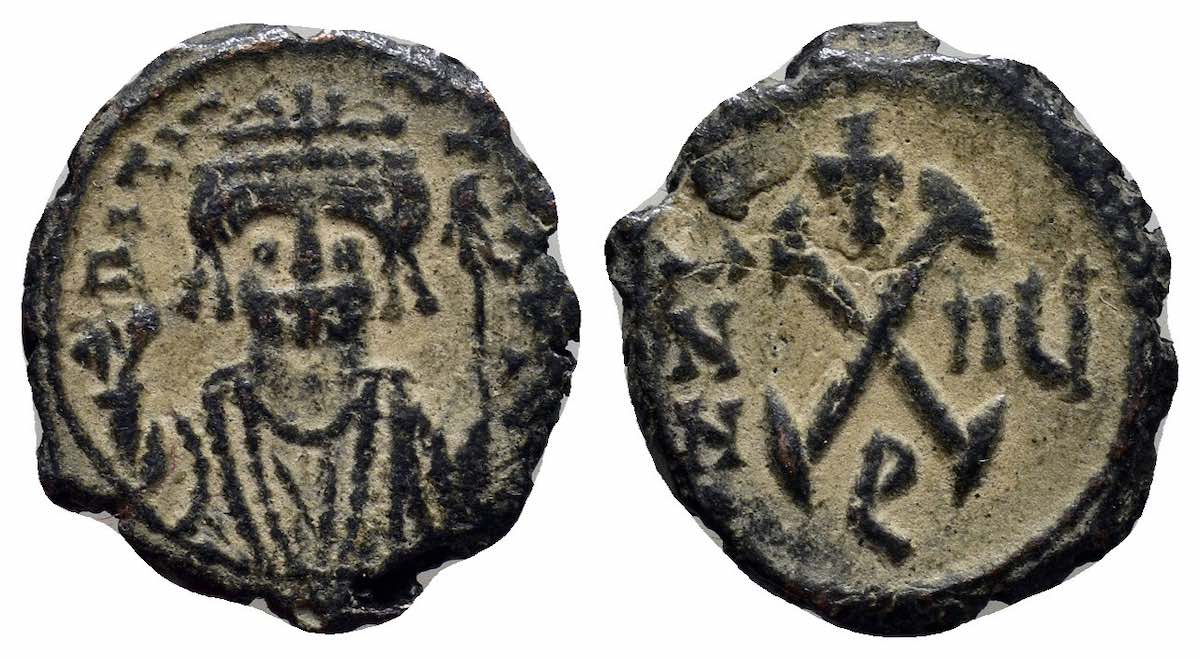 Maurice, 582-602
Maurice, 582-602
18-17 mm. 2.59 grams.
Antioch
Sear 536
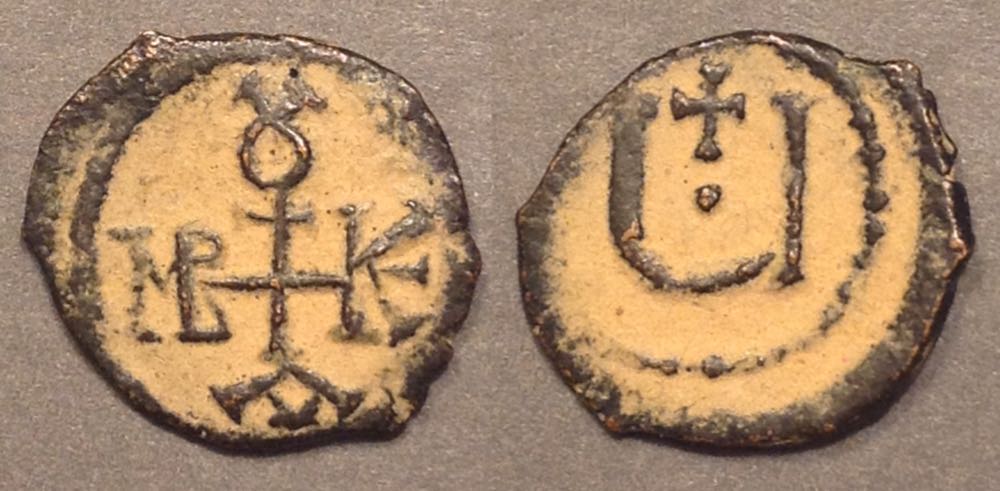 Maurice, 582-602
Maurice, 582-602
14.7-13.1 mm. 1.23 grams.
Pentanumium
Not in Sear, but similar to Sear 540
Which has the monogram "A" crossed, where this one does not.
 Maurice, 582-602
Maurice, 582-602
12.6 mm. 1.35 grams.
Pentanumium
Sear 542. Line-drawing in Sear. Only one cited in MIBE.
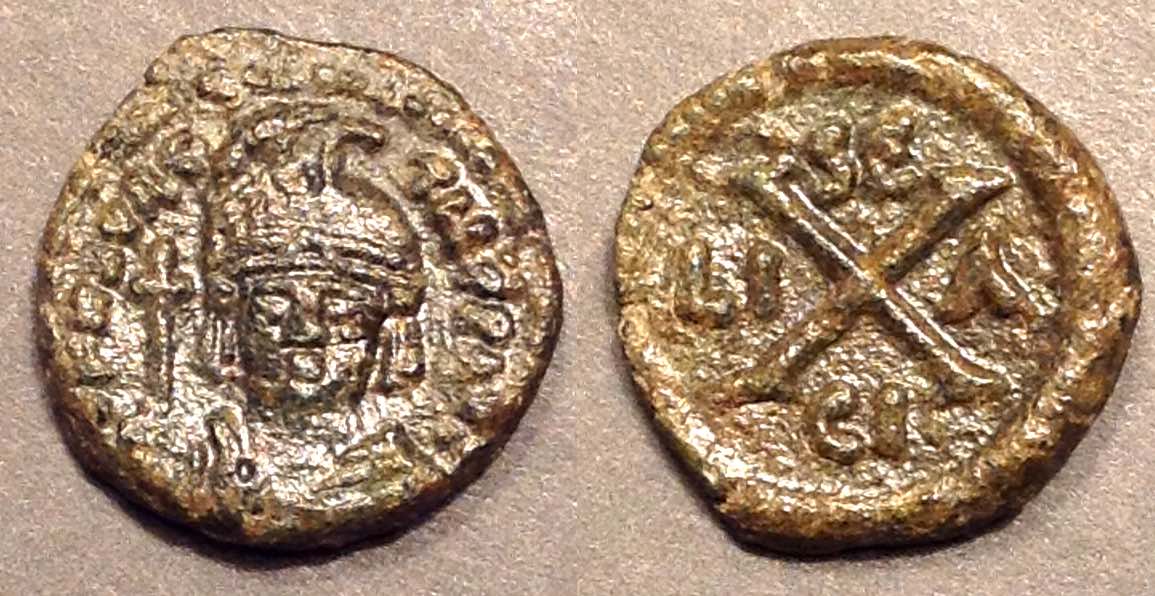 Maurice, 582-602
Maurice, 582-602
15.6 mm. 3.13 mm.
SE
LI A
CI
for SICΙLIA
Strck 588-602 at Syracuse
Sear 583
 Revolt of the Heracli, 608-612
Revolt of the Heracli, 608-612
30-27 mm. 9.11 grams
Alexandretta mint
Rare.
The Heraclei take the title "Consul" during their revolt, not "Augustus."
Sear 722
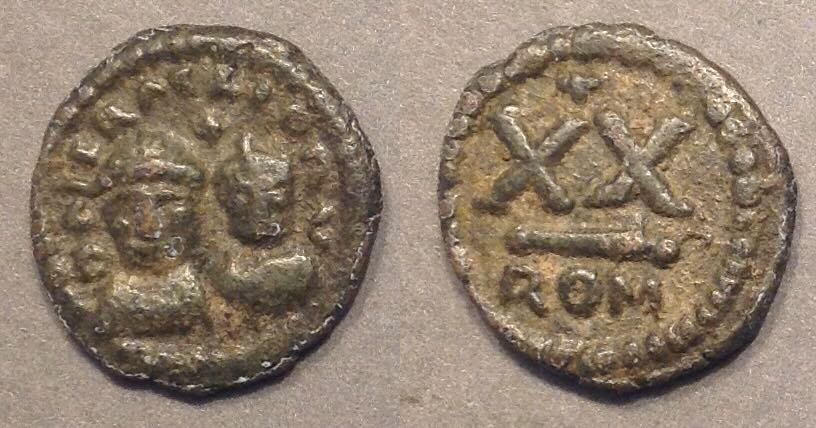 Heraclius, 610-641
Heraclius, 610-641
17 mm. 3.03 grams.
+
X X
ROM
Sear 889 Rome mint.
DOC 2.1 Heraclius 261
Philippicus, 711-713
21.5 - 19 mm.
SCL for Syracuse mint
Sear 1460A
(I think this is the finest on the web.)
 Leo III and Constantine V, 720-741
Leo III and Constantine V, 720-741
22.6-19.4 mm. 2.87 grams.
Sear 1516.
This is a rare type. It could be much nicer, but at least it has the critcial and distinctive right arms across the bodies.
Leo III and Constantine V, 720-741
18-17 mm. 2.41 grams.
The half-follis companion to the above follis.
Sear 1520
Very rare in better condtion than this one.
 Michael I, 811-813
Michael I, 811-813
23-21 mm. 4.95 grams. Small.
It is uncertain if this really is Michael I with Theophylactus or
Michael II and Theophilus. ("ΘEOF" could be for either.) See the next coin.
The smaller size is more like the coins from just before the reign of Michael I and the larger coins of this design are known to be of Michael II.
Sear 1618
 Michael II and Theophilus, 821-829
Michael II and Theophilus, 821-829
30 mm. 7.72 grams.
Sear 1642
 Constantine VII, 913-959
Constantine VII, 913-959
26-25 mm.
Struck 920-931
Sear 1759
Rare with the standard.
 Constantine VII (913-959) and Zoe (914-919)
Constantine VII (913-959) and Zoe (914-919)
25.5-24.8 mm. 6.98 grams.
Sear 1758
Unusual heavy green patina
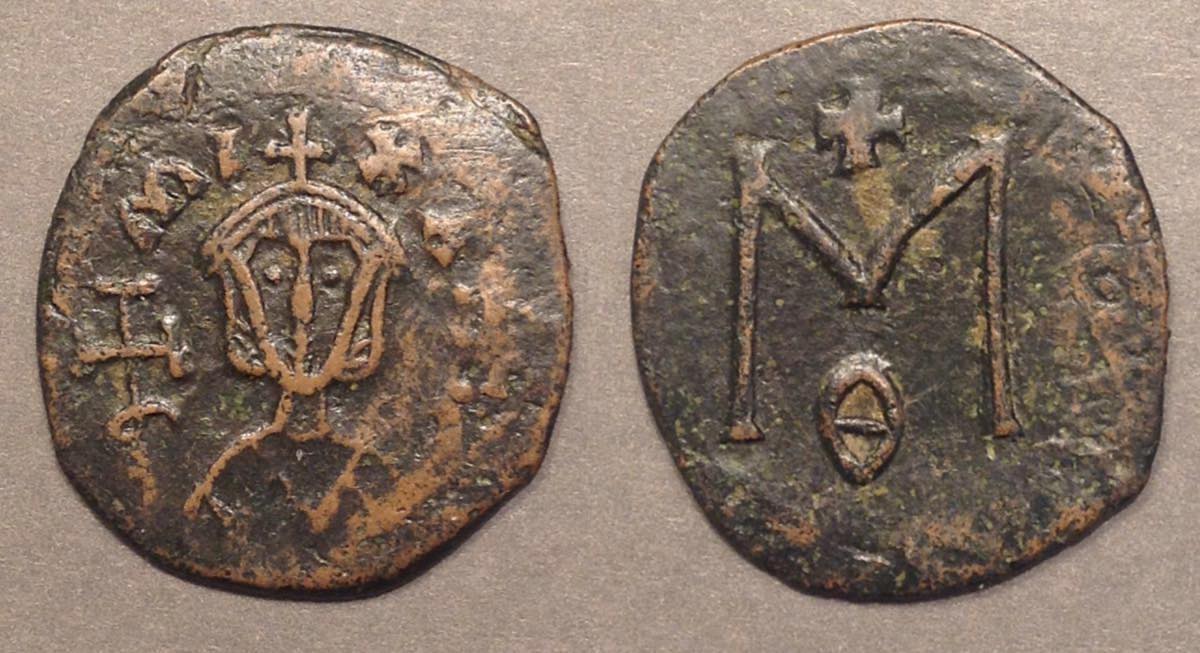 Michael II, 842-867, alone
Michael II, 842-867, alone
23-21 mm. 3.67 grams.
Syracuse mint
Sear 1697

Nicephorus II, 963-969
26-25 mm. 6.98 grams.
Sear 1782
Unusually large and full flan for type.
Constantine X, 1059-1067
27-24 mm. 8.08 grams.
Unusually nice bust of Constantine X on the reverse, with a legible legend.
Sear 1854
Turkoman:
 Rukn al-Din Mawdud, Artuqid ruler of Hisn Kayfa and Amid
Rukn al-Din Mawdud, Artuqid ruler of Hisn Kayfa and Amid
AH 619-629. AD 1222-1232.
27 mm. 10.32 grams.
Two-headed eagle in circle in square in circle
S&S 19
 Turkoman. Begteginid.
Turkoman. Begteginid.
Muzaffar al-Din Kokburi [Gokburi, Gokbori]
AH 563-630
AD 1168-1233
(coins 1193-1233)
Enthroned facing figure
3-line legend in square. Legend outside square.
SSS Beg-3
 Qilij Arslan II
Qilij Arslan II
AH 551-588
AD 1156-1192
20-29 mm. 2.98 grams.
Enthroned figure facing slightly right
3-line legend
Not very nice, nevertheless, the nicest one on the web.
 Shams al-Din Isma'il b. Ibrahim
Shams al-Din Isma'il b. Ibrahim
AH 559 - 567
AD 1164 - 1172
30-29 mm. 7.58 grams.
Danishmendids of Sivas
Seated figure in circle, feet on the ground, legend around.
SSS Dan-8
One of the nicest and most legible of its type.
Nice rust-colored surface.
 Sultanate of Egypt
Sultanate of Egypt
al-Nasir I Salah al-Din Yusuf (Saladin)
AH 564-589, AD 1169-1193
30-29 mm. 7.58 grams.
No mint given, perhaps Harran. Mesopotamian style.
Dated 582
Lion seated ("sejant") left in circle, legend around
"Constellation of the lion [Leo]"
4-line legend in circle, legend around
This type is rare, but it does come nicer.
Crusader:
 Baldwin I, AD 1098-1100. 25 mm and 6.89 grams. Struck at Edessa.
Baldwin I, AD 1098-1100. 25 mm and 6.89 grams. Struck at Edessa.
Obverse: The bust of Christ facing, nimbate (i.e. with a halo), holding the gospels. IC XC (for Jesus Christus) either side. No other obverse legend.
Reverse: A cross on two steps, large pellets at the ends ("cross pattée"), wedge in each angle, with letters for Baldwin in the quadrants.
B Λ
Δ N for BAΛΔOINOC "Baldwin")
This first type resembles contemporary Byzantine coins. It is rare. I have not seen one in better condition in any reference or on the web.
CCS Edessa 1b. Metcalf --. Metcalf has no examples, but the type is discussed on pages 33-35 with a line drawing.
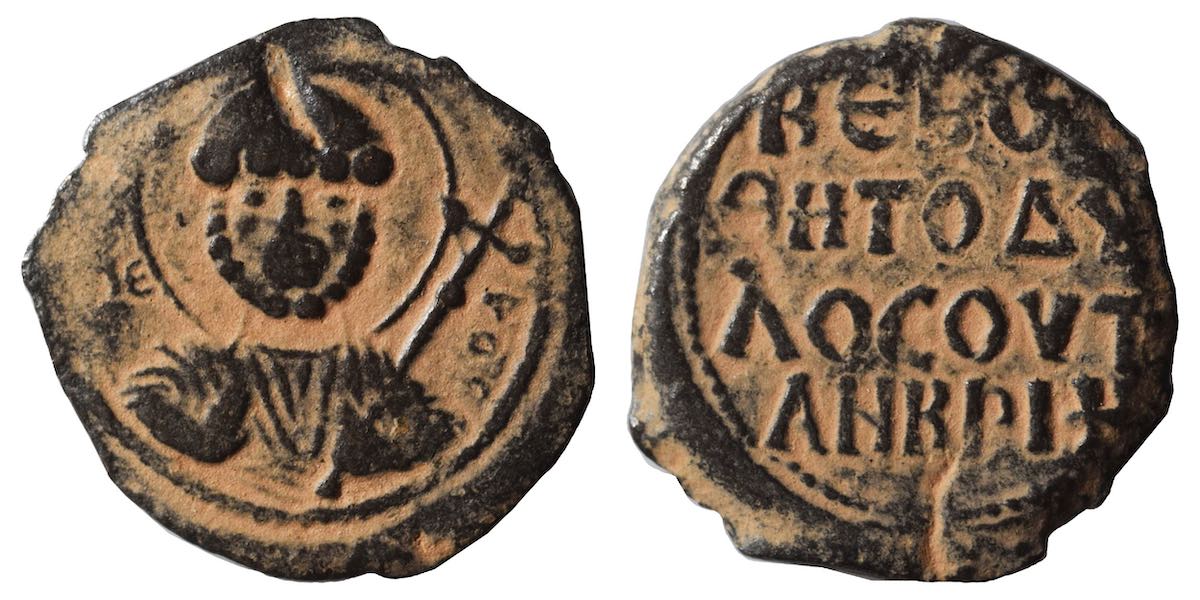 Tancred, regent at Antioch, 1101-1112.
Tancred, regent at Antioch, 1101-1112.
23.4 mm. 4.48 grams.
Obverse: Bust of St. Peter facing, nimbate, with scroll in left and diagonal long cross in right.
Θ/ΠЄ to left and POC down the right (Identifying St. Peter)
Reverse: Legend in four lines:
KЄBOI
ΘHTOΔV
ΛOCOVT (His name begins here: T-ANKRI[D])
ANKRI+
"Oh Lord come to the aid of thy servant Tancred"
CCS Antioch 3 (page 199) Tancred's first type of four.
Metcalf 49-62. Also page 25, type 6.
 Tancred, regent at Antioch, 1101-1112. 1101-1112.
Tancred, regent at Antioch, 1101-1112. 1101-1112.
22 mm. 4.18 grams.
His fourth type of four.
St. Peter, standing, with right hand extended in blessing and left holding a long cross.
S PE TPV either side, for "St. Peter"
Square cross with
D S
F T in the quadrants, for
"Domine Salvum Fac Tancredum"
"Lord, save Tancred"
CCS Antioch 6, Tancred's fourth type.
Metcalf 71-80 (all not as nice as this one), Type 5 page 27.
 Baldwin II, at Edessa. Second reign, 1108-1118.
Baldwin II, at Edessa. Second reign, 1108-1118.
25 mm. 3.90 grams.
Struck after c. 1110, his third type.
Count in armor walking left, holding cross in right hand with his left hand on the hilt of his sword at his waist. Legend around, usually flat and illegible but on this example much can be seen. Notice the armor.
(From 1:00) BAΓΔOVNOC ΔO-YΛO CATV (some letters ligate) ("Baldwin, servant of the cross") By the way, the reason for this spelling of "Baldwin" on these coins is Armenian influence which is discussed by Murray in NC.
Cross with floral ornament at the base, much like a Class I Byzantine anonymous follis. Pellets in the angles and pellets alongside the ends of the cross.
CCS Edessa 9a. The first issue of the "light series" of Baldwin II which follows two much heavier types (not shown here) which are very rare and always very poorly struck.
Metcalf 109-111 (111 has the same obverse die.)
Go back to Greek, Roman Republican, Imperial and provincial, Byzantine, Turkoman, Crusader
 Alexander the Great
Alexander the Great Alexander the Great
Alexander the Great Roman Republican
Roman Republican Vespasian and Titus
Vespasian and Titus Anonymous quadrans
Anonymous quadrans Hadrian, 117-138
Hadrian, 117-138 Septimus Severus
Septimus Severus Caracalla
Caracalla Maximinus Thrax, 235-238
Maximinus Thrax, 235-238 Otacilia Severa, wife of Philip I (244-249)
Otacilia Severa, wife of Philip I (244-249) Claudius II, 268-270
Claudius II, 268-270 Aurelian, 270-275
Aurelian, 270-275 Diocletian, 284-305
Diocletian, 284-305 Diocletian, 284-305
Diocletian, 284-305
 Galerius, as Augusus
Galerius, as Augusus Constantine as Caesar, 306-307
Constantine as Caesar, 306-307 Crispus, 317-326
Crispus, 317-326 Fausta, wife of Constantine. d. 326
Fausta, wife of Constantine. d. 326 Delmatius, 335-337
Delmatius, 335-337 ROMA
ROMA Justin, 518-527
Justin, 518-527 Justinian, 527-565
Justinian, 527-565
 Justinian, 527-565
Justinian, 527-565 Justinian, 527-565
Justinian, 527-565 Tiberius II, 578-582
Tiberius II, 578-582 Maurice, 582-602
Maurice, 582-602 Maurice, 582-602
Maurice, 582-602 Maurice, 582-602
Maurice, 582-602 Maurice, 582-602
Maurice, 582-602 Maurice, 582-602
Maurice, 582-602 Revolt of the Heracli, 608-612
Revolt of the Heracli, 608-612  Heraclius, 610-641
Heraclius, 610-641
 Leo III and Constantine V, 720-741
Leo III and Constantine V, 720-741
 Michael I, 811-813
Michael I, 811-813 Michael II and Theophilus, 821-829
Michael II and Theophilus, 821-829 Constantine VII, 913-959
Constantine VII, 913-959 Constantine VII (913-959) and Zoe (914-919)
Constantine VII (913-959) and Zoe (914-919) Michael II, 842-867, alone
Michael II, 842-867, alone Nicephorus II, 963-969
Nicephorus II, 963-969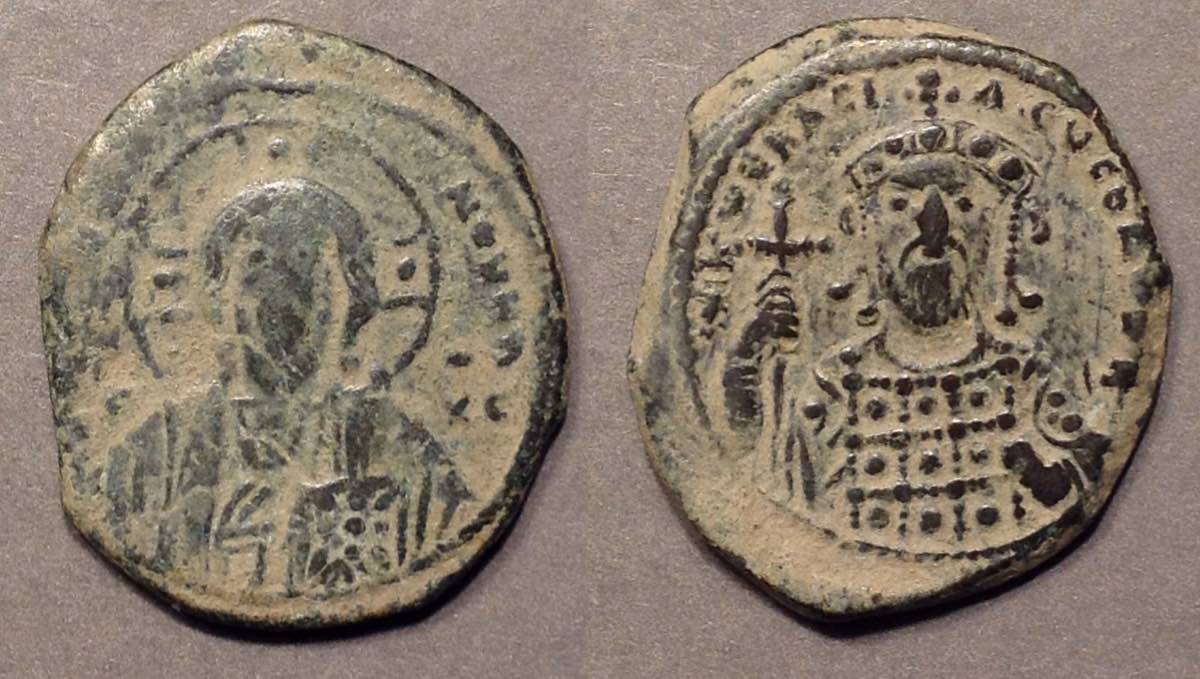
 Rukn al-Din Mawdud, Artuqid ruler of Hisn Kayfa and Amid
Rukn al-Din Mawdud, Artuqid ruler of Hisn Kayfa and Amid Turkoman. Begteginid.
Turkoman. Begteginid. Qilij Arslan II
Qilij Arslan II Shams al-Din Isma'il b. Ibrahim
Shams al-Din Isma'il b. Ibrahim Sultanate of Egypt
Sultanate of Egypt Baldwin I, AD 1098-1100. 25 mm and 6.89 grams. Struck at Edessa.
Baldwin I, AD 1098-1100. 25 mm and 6.89 grams. Struck at Edessa.  Tancred, regent at Antioch, 1101-1112.
Tancred, regent at Antioch, 1101-1112.  Tancred, regent at Antioch, 1101-1112. 1101-1112.
Tancred, regent at Antioch, 1101-1112. 1101-1112.  Baldwin II, at Edessa. Second reign, 1108-1118.
Baldwin II, at Edessa. Second reign, 1108-1118.